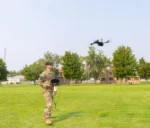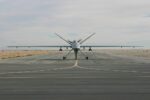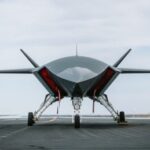Australia has officially received its first batch of Boeing AH-64E Apache Guardian attack helicopters as part of a broader effort to modernize the Australian Army’s rotary-wing combat capabilities. The delivery marks a significant milestone under the LAND 4503 Armed Reconnaissance Helicopter Replacement project.
First Apaches Arrive at RAAF Base Townsville
On October 5, 2025, the first two AH-64E Version 6 helicopters arrived at RAAF Base Townsville in Queensland. These aircraft are part of an initial delivery from Boeing’s Mesa production facility and represent the vanguard of a total order of 29 Apaches approved under Australia’s LAND 4503 program. The Australian Department of Defence (DoD) confirmed that these aircraft will undergo acceptance testing and initial training before entering operational service with the Australian Army’s 1st Aviation Regiment.
The selection of Townsville as the primary basing location aligns with Australia’s strategic posture in the Indo-Pacific region and facilitates joint training opportunities with U.S. forces stationed in northern Australia under Force Posture Initiatives (FPI).
Replacing the Tiger ARH Fleet
The AH-64E replaces Airbus’s Eurocopter Tiger Armed Reconnaissance Helicopter (ARH), which has faced persistent issues since entering service in Australia in the mid-2000s. Despite upgrades and local support efforts, the Tiger fleet struggled with sustainment challenges and limited interoperability with allied forces.
In January 2021, Canberra announced its decision to acquire the Apache Guardian after a competitive evaluation process that included Bell’s AH-1Z Viper and other contenders. The U.S. State Department approved Australia’s request for up to 29 Apaches via Foreign Military Sales (FMS) in June 2021 at an estimated cost of $3.5 billion AUD (~$2.7 billion USD). The contract includes sensors, munitions packages (including AGM-114R Hellfire missiles), training systems, spares, and ground support equipment.
AH-64E Capabilities and Customization for ADF
The AH-64E Version 6 is Boeing’s most advanced configuration to date. It features:
- Improved T700-GE-701D engines for enhanced hot/high performance
- Manned-Unmanned Teaming (MUM-T) capability enabling control over UAVs such as Shadow or future tactical drones
- Modernized Target Acquisition Designation Sight/Pilot Night Vision Sensor (M-TADS/PNVS)
- Link-16 datalink integration for network-centric operations
- Advanced survivability suite including radar warning receivers and countermeasures dispensers
- Open systems architecture for easier software upgrades and mission system integration
The Australian variant is expected to retain full compatibility with U.S. Army configurations to ensure interoperability during coalition operations. However, some customization is anticipated—particularly around communications systems to integrate with ADF C4I networks such as JP9102 SATCOM and Land Command Support System (LCSS).
Pilot Training and Sustainment Ecosystem
Boeing Defence Australia will play a central role in supporting local sustainment activities through partnerships with regional industry players including BAE Systems Australia and Raytheon Australia. The long-term support model includes:
- Australian-based pilot training simulators co-located at RAAF Townsville
- Ammunition storage facilities for Hellfire missiles and future Joint Air-to-Ground Missiles (JAGM)
- A logistics framework aligned with U.S. Army global supply chains
- Maintenance workforce development programs to reduce reliance on overseas depot-level support
Pilot conversion courses have already begun using U.S.-based facilities while domestic infrastructure is being completed by mid-2026.
Strategic Implications for Indo-Pacific Deterrence
The introduction of Apaches significantly boosts Australia’s ability to conduct high-intensity combined arms operations across contested environments—particularly within littoral zones or dense terrain where fixed-wing CAS may be limited.
This acquisition also enhances interoperability with key partners such as the United States Marine Corps (USMC), which regularly deploys MV-22B Ospreys and AH-1Z Vipers through Darwin-based rotations under Marine Rotational Force–Darwin (MRF-D). With Link-16 compatibility and shared tactics/procedures developed through multinational exercises like Talisman Sabre or Pitch Black, Australian Apaches will be able to seamlessly plug into allied kill chains.
Next Steps Under LAND Programs
The Apache acquisition forms one pillar within a broader modernization drive across Army Aviation under Project LAND series initiatives:
- LAND 4507: Future Tactical Uncrewed Aerial Systems (FTUAS) integration alongside MUM-T capable platforms like Apache
- LAND 9000: Rotary wing training system overhaul including EC135 replacement options
The final delivery of all AH-64Es is expected by late FY2028 barring delays from production bottlenecks or export restrictions. As geopolitical tensions persist across Southeast Asia and near-peer competition intensifies globally, Canberra appears committed to maintaining credible deterrence through technologically advanced force multipliers like the Apache Guardian.









